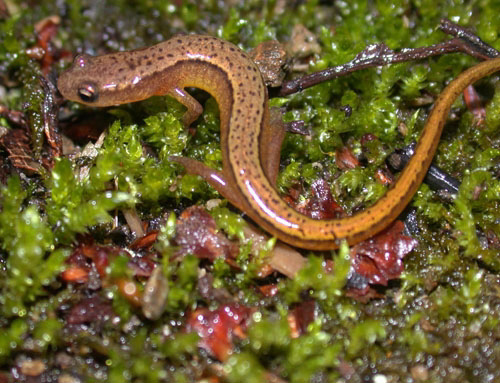The northern two-lined salamander is a member of the lungless salamander family. Adult salamanders in this family do not have lungs but take in oxygen through their skin. Northern two-lined salamanders are smooth-skinned and are yellowish or orangish brown. They have two dark stripes along each upper side from eye to tail, and two yellowy stripes alongside the dark stripes. They may have small black speckles. They have long tails and can be 4 inches long.
The range of the northern two-lined salamander in the US is east of the Mississsippi River but not in Florida or Michigan. They have no protected status in Connecticut.
Adult northern two-lined salamanders are live in streams with rocky beds. They are often underneath the rocks in such streams. They have been found under flat rocks in swamps and floodplains as well so running water may not be a necessity. Adults are active for a long period, sometimes from February to November.
Northern two-lined salamanders mate in streams from September through May. During the courtship the male pokes the female with his head, coils his body around her head and scratches her with his teeth. She lays her head at the base of his tail and they walk entwined for awhile. He will then deposit a sperm packet which she picks up through her cloaca, the opening amphibians use for breeding, egg-laying and waste. Her eggs are fertilized internally. Eggs are laid under rocks in streambeds in May and June and hatch in 4 to 10 weeks. Many females may lay eggs in one spot leading to larger eggs masses at different stages of development. One female adult may guard the combined clutches until they hatch. The aquatic larvae are dark brown with light spots and well-developed gills. They metamorphisize into adults in 2 to 3 years.
Adult northern two-lined salamanders eat small insects and invertebrates, as do their larvae.
